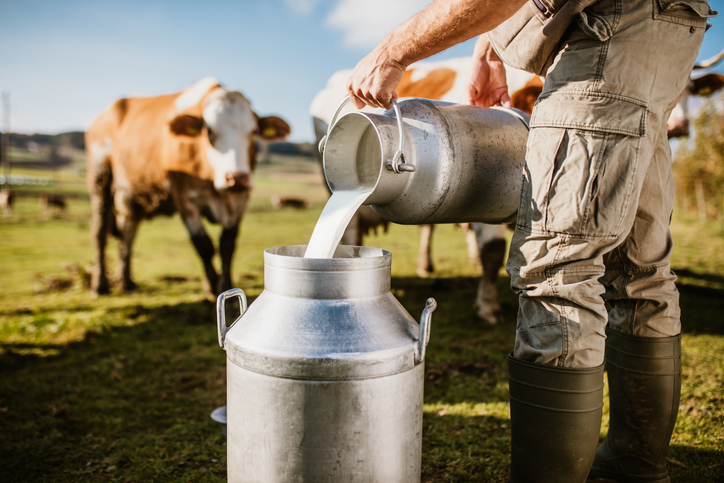Let's talk about lab water
Let's talk about lab water
 Researchers examine the mineral composition of human and cattle milk to enable a better comparison of their relative nutritional importance for growing children.
Researchers examine the mineral composition of human and cattle milk to enable a better comparison of their relative nutritional importance for growing children.
In a new study, researchers measure the mineral content of milk from cattle and humans – and estimate the daily intake of these elements for children from consuming milk.1
The researchers collected milk samples from cattle (goat, sheep, cow, buffalo and camel) from farms and flocks from rural areas of Hyderabad city in Pakistan and healthy lactating women. After acid digestion, they used a variety of techniques to determine the concentration of selected electrolytes and essential trace elements as total and soluble (whey) forms.
The team used ultrapure water generated from an ELGA PURELAB® laboratory water purification system for their experiments, minimising the risk of adding contaminants that might affect their results.
The researchers found that the concentrations of sodium (Na), potassium (K), calcium (Ca), magnesium (Mg) and phosphorous (P) were higher in camel milk, whilst K content was elevated in goat and sheep milk.
Human milk contained the lowest concentrations of iron (Fe), zinc (Zn), copper (Cu) compared to the different types of cattle milk, but had the highest levels of selenium (Se).
In addition, the team collected information about the type and amount of milk consumed by local children between six months and 10 years of age. They used these data to estimate the daily intake of each selected element, showing that the different types of milk make a positive contribution towards the recommended daily allowances of all these minerals.
This study highlights there are wide variations in the mineral composition of milk from different species. Each type has a specific pattern of electrolytes and essential trace elements, which might be an indicator of their relative nutritional importance for humans of all age groups.
Human breast milk contains higher levels of Se compared to all types of cattle milk, suggesting these compounds are more biologically available to infants than those obtained from consuming cattle milks.
As most of the mothers in rural areas of Pakistan will have low contents of essential minerals in their breast milk, the authors suggest that cow and goat milk may help support infant nutritional requirements for supporting healthy growth.
At ELGA LabWater, our expert engineers, chemists and scientists are at the forefront of technological innovation. They continue to introduce game-changing features to the lab water market.
Milk is an excellent source of energy and many essential nutrients important for our health. As well protein, fat, carbohydrates and vitamins, it also contains a variety of minerals that provide electrolytes and essential trace elements necessary to support the growth of infants and young children.
Human breast milk is the preferred food for babies under six months, providing all the energy and nutrients they need while their gut develops and matures. But the milk from different species of cattle may be introduced for weaning infants and young children at later ages.
The vast majority of global milk production comes from cows, sheep and goats. But in certain regions of the world the milk of different cattle, such as camels or buffalos, can offer alternatives. But the concentration of the different nutritional components in milk is known to vary widely across species.
Elemental analysis
In a new study, researchers measure the mineral content of milk from cattle and humans – and estimate the daily intake of these elements for children from consuming milk.1
The researchers collected milk samples from cattle (goat, sheep, cow, buffalo and camel) from farms and flocks from rural areas of Hyderabad city in Pakistan and healthy lactating women. After acid digestion, they used a variety of techniques to determine the concentration of selected electrolytes and essential trace elements as total and soluble (whey) forms.
The team used ultrapure water generated from an ELGA PURELAB® laboratory water purification system for their experiments, minimising the risk of adding contaminants that might affect their results.
Large variations
The researchers found that the concentrations of sodium (Na), potassium (K), calcium (Ca), magnesium (Mg) and phosphorous (P) were higher in camel milk, whilst K content was elevated in goat and sheep milk.
Human milk contained the lowest concentrations of iron (Fe), zinc (Zn), copper (Cu) compared to the different types of cattle milk, but had the highest levels of selenium (Se).
In addition, the team collected information about the type and amount of milk consumed by local children between six months and 10 years of age. They used these data to estimate the daily intake of each selected element, showing that the different types of milk make a positive contribution towards the recommended daily allowances of all these minerals.
Supporting healthy growth
This study highlights there are wide variations in the mineral composition of milk from different species. Each type has a specific pattern of electrolytes and essential trace elements, which might be an indicator of their relative nutritional importance for humans of all age groups.
Human breast milk contains higher levels of Se compared to all types of cattle milk, suggesting these compounds are more biologically available to infants than those obtained from consuming cattle milks.
As most of the mothers in rural areas of Pakistan will have low contents of essential minerals in their breast milk, the authors suggest that cow and goat milk may help support infant nutritional requirements for supporting healthy growth.
Why choose ELGA LabWater
At ELGA LabWater, our expert engineers, chemists and scientists are at the forefront of technological innovation. They continue to introduce game-changing features to the lab water market.